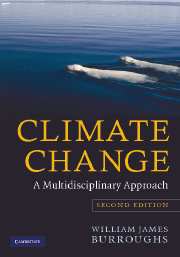Book contents
- Frontmatter
- Contents
- Preface to the second edition
- 1 Introduction
- 2 Radiation and the Earth's energy balance
- 3 The elements of the climate
- 4 The measurement of climate change
- 5 Statistics, significance and cycles
- 6 The natural causes of climate change
- 7 Human activities
- 8 Evidence of climate change
- 9 Consequences of climate change
- 10 Modelling the climate
- 11 Predicting climate change
- Glossary
- Bibliography
- Index
2 - Radiation and the Earth's energy balance
Published online by Cambridge University Press: 05 June 2012
- Frontmatter
- Contents
- Preface to the second edition
- 1 Introduction
- 2 Radiation and the Earth's energy balance
- 3 The elements of the climate
- 4 The measurement of climate change
- 5 Statistics, significance and cycles
- 6 The natural causes of climate change
- 7 Human activities
- 8 Evidence of climate change
- 9 Consequences of climate change
- 10 Modelling the climate
- 11 Predicting climate change
- Glossary
- Bibliography
- Index
Summary
And God said, Let there be light: and there was light.
Genesis 1,1.Although a wide range of factors governs the Earth's climate, the essential, driving process is the supply of energy from the Sun and what happens to this is energy when it hits the Earth. To understand how this works, we must consider the following processes:
(a) the properties of solar radiation and also how the Earth re-radiates energy to space;
(b) how the Earth's atmosphere and surface absorb or reflect solar energy and also re-radiate energy to space; and
(c) how all these parameters change throughout the year and on longer timescales.
The consideration of variations over timescales longer than a year has to take account of the fact that many of the most important changes may occur over widely differing periods (i.e. from a few years to hundreds of millions of years). The differing time horizons cannot be specified in advance and so we may find ourselves moving back and forth over this wide range as we progress through the book. The only way to deal with these shifts in timescale is to identify clearly what we are talking about as we go along.
Solar and terrestrial radiation
At the simplest level the radiative balance of the Earth can be defined as follows: over time the amount of solar radiation absorbed by the atmosphere and the surface beneath it is equal to the amount of heat radiation emitted by the Earth to space.
- Type
- Chapter
- Information
- Climate ChangeA Multidisciplinary Approach, pp. 11 - 35Publisher: Cambridge University PressPrint publication year: 2007



